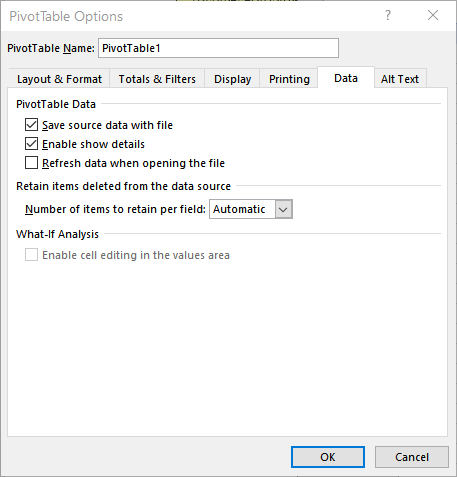Please Note: This article is written for users of the following Microsoft Excel versions: 2007, 2010, 2013, 2016, 2019, and 2021. If you are using an earlier version (Excel 2003 or earlier), this tip may not work for you. For a version of this tip written specifically for earlier versions of Excel, click here: Editing PivotTables without Underlying Data.
Written by Allen Wyatt (last updated September 4, 2021)
This tip applies to Excel 2007, 2010, 2013, 2016, 2019, and 2021
Stephen works with workbooks that originate with other people in his company. These workbooks regularly have PivotTables in them. It seems that Stephen cannot edit some of the PivotTables, instead getting an error message that says the "underlying data was not included." This is a bit confusing, since Stephen received the entire workbook.
Normally this error occurs not when the underlying data is not present in the workbook, but when the underlying data cache is not saved with the PivotTable. This is usually done in an attempt to create a smaller file when the workbook is saved.
In order to edit the PivotTable, try simply refreshing the data (right-click the table and choose Refresh Data). If this doesn't work, or if you want to eliminate the message entirely, then you can follow these steps:

Figure 1. The Data tab of the PivotTable Options dialog box.
You should note that when this option is selected, the file size of your workbook can be significantly larger than if the option is not selected. This is a tradeoff, however, as the PivotTable should display quicker since it is working with the data in the cache.
If these techniques don't work, it could be because the underlying data for the PivotTable really isn't in the workbook. If you poke around in the workbook and cannot find the data, then it could be that the data was being pulled from an external source—outside of Excel. If this is the case (you will need to check with the PivotTable's author to verify this) and if the PivotTable options have been set to not save the cache, as previously described, then you won't be able to make edits.
If you determine that this is the case with your situation, then you'll need to have the original author again generate the PivotTable and make sure that the Save Source Data with File option is checked.
ExcelTips is your source for cost-effective Microsoft Excel training. This tip (10089) applies to Microsoft Excel 2007, 2010, 2013, 2016, 2019, and 2021. You can find a version of this tip for the older menu interface of Excel here: Editing PivotTables without Underlying Data.

Excel Smarts for Beginners! Featuring the friendly and trusted For Dummies style, this popular guide shows beginners how to get up and running with Excel while also helping more experienced users get comfortable with the newest features. Check out Excel 2019 For Dummies today!
PivotTables are used to analyze huge amounts of data. The number of rows used in a PivotTable depends on the type of ...
Discover MoreWonder what happened to the data behind a PivotTable? It could be in a number of places, and tracking it down could be a ...
Discover MorePivotTables are great for digesting and analyzing huge amounts of data. But what if you want part of that data excluded, ...
Discover MoreFREE SERVICE: Get tips like this every week in ExcelTips, a free productivity newsletter. Enter your address and click "Subscribe."
2021-09-04 11:20:42
Philip
In a number of cases the source data are just in a different workbook, not accessible to the recipient of the pivot. This is often (in my case) intentional to provide the user with a sliced subset of information without granting access to all of it … a great and easy way to build in some kind of “confidentiality” without complicated protections …
Got a version of Excel that uses the ribbon interface (Excel 2007 or later)? This site is for you! If you use an earlier version of Excel, visit our ExcelTips site focusing on the menu interface.
FREE SERVICE: Get tips like this every week in ExcelTips, a free productivity newsletter. Enter your address and click "Subscribe."
Copyright © 2026 Sharon Parq Associates, Inc.
Comments